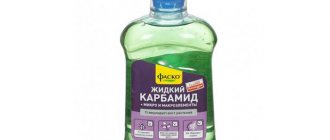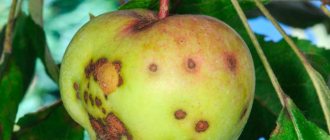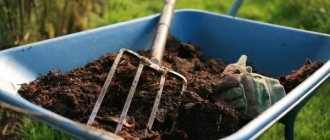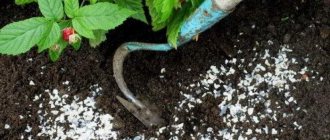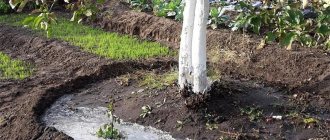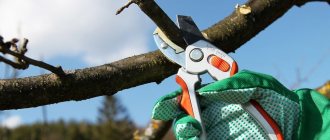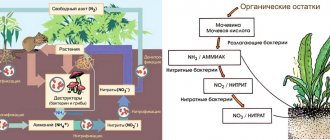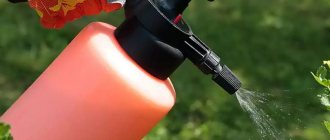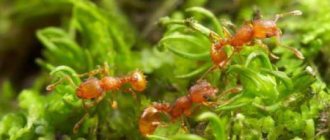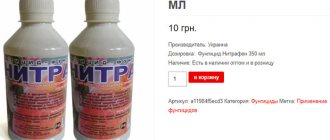Urea as a fertilizer for the garden
Like any other nitrogen-containing fertilizer, urea is necessary for all plants. But most often it is used to treat trees and shrubs. Nitrogen directly affects the growth rate of fruits - berries and fruits. If this element is missing, then less green mass will be processed than necessary. The plant also does not develop in height, the fruits become smaller, the color of the leaves is less pronounced.
Plants can obtain nitrogen from the air and soil. But often its concentration in such cases is too low, and additional application to the soil and treatment of the garden with urea is recommended. When the compound gets into the soil, through chemical reactions it turns into ammonium carbonate in a few days. There is an important element in this reaction - the vital activity of soil bacteria, which make such a process possible.
The new compound will be easily taken up from the soil by plants, and no side effects will appear. At the same time, treating trees and shrubs with urea will prevent the development of infectious diseases and attacks by insect pests.
Interaction with other fertilizers
Urea, as a chemical element, reacts with other substances. This determines its compatibility with other mineral and organic fertilizers. We get a good combination when it is added simultaneously with:
- potassium chloride;
- potassium sulfate;
- sodium nitrate;
- manure.
Combined use with such substances is not allowed:
- gypsum;
- chalk;
- dolomite;
- calcium nitrate;
- superphosphate;
- wood ash.
Important. The simultaneous application of fertilizers that enter into a chemical reaction and inhibit the beneficial effects of each other is unacceptable. Such feeding will not be effective.
Urea for the destruction of diseases and pests
Experienced gardeners know how many problems pests can cause, how the activity of such insects affects the condition of the garden, and how difficult it is to save the crop.
The use of urea helps stop the spread of pests throughout the area and makes it easier to care for plants.
Aphids on an apple tree.
Aphid
Urea is the granules from which the solution is prepared. To combat aphids, make a solution in the following proportion - 500-700 g of product per bucket of water. The consumption of the finished composition should be 2.5 liters per 10 sq.m. This treatment is carried out in the spring. The solution in the specified concentration can be used to treat plants not only against aphids, but also against weevils and apple blossom beetles.
In autumn, the procedure is performed slightly differently. Take 700 g of urea in granules per bucket of water, but additionally mix it with copper sulfate (50 g). The last substance is copper sulfate.
To combat aphids, it is important to spray not only the crown of the tree and its trunk, but also fallen leaves.
Colorado beetle
The pest's favorite crop is potatoes. There are different methods of combating the Colorado potato beetle, but the simplest option is treating the tops with a urea solution. To do this, the granules are mixed with water in equal proportions.
There is one more effective method. In early spring, bait is made from old tubers soaked in a urea solution. These potatoes are simply laid out in the area where they are going to plant the crop, and after some time they are collected along with the pests and destroyed.
Nematodes
Nematodes are worms that feed on plant roots, causing crop death. It is difficult to fight them - to do this you will first have to get rid of the infected plants. They should be dug up along with the soil and burned or a special hole should be made for them, which should be filled with urea (the dosage is 5 kg of granules per 1 cubic meter). Afterwards, the area is treated with urea in a proportion of 200 g per 1 sq.m.
If the site is not infested with pests, and measures are carried out for preventive purposes, urea is added to the soil in the fall when plowing the site (at the rate of 100 g per 1 sq.m.)
Lichen on an apple tree.
Diseases
Urea does not help with all diseases. But it is effective if the plants have scab, purple spot and monilial burn.
Treatment is carried out with a concentrated solution - 500 g of urea per bucket of water.
Instructions for using urea fertilizer
The chemical formula of urea and its properties indicate that it should be used as a preparation for sowing. It slowly decomposes and saturates the soil with all the necessary substances to normalize plant growth. After use, the productivity of vegetable and garden crops increases, and the level of protein in cereals becomes higher.
Urea is well suited for the prevention of pests and various diseases.
The fertilizer is also suitable for fighting fungal infections. Plants can be treated with urea against the following insects:
- slowpoke;
- aphid;
- flower beetle;
- weevil.
Advantages and disadvantages
Urea has many advantages:
- Almost instantaneous onset of action, while the effect lasts for a long time.
- Versatility. The method works regardless of soil type or conditions (for example, the effectiveness will be the same for greenhouses and open ground).
- It is safe to use not only in spring or autumn, but also in summer. Although the proportions when preparing the solution must be observed, if they are accidentally violated, there will be no catastrophic consequences (for example, leaf burns). Violation of the recipe can only affect the effectiveness of spraying, but even then only slightly.
- A slight delay in the growing season when spraying trees and shrubs in spring. This slowdown even benefits the plants, since it protects the ovaries from sudden frosts. Therefore, fruit crops are sprayed first.
- Increased yields provided that the treatment is carried out during the period of bud formation, since urea protects fruit trees from pests.
Urea can also be applied to waterlogged soil. The urea solution has one more property - it allows you to quickly clear the area of old stumps, since it accelerates the process of their rotting.
Spraying with urea also has disadvantages, although they are few. They are mainly due to the fact that the fertilizer cannot be used simultaneously with nitrogen compounds, chalk and lime. But the most restrictions are associated with the incorporation of urea into the soil. Urea quickly disappears from the soil, and more worries arise related to organizing regular watering.
In addition, the addition of urea leads to an increase in acidity. Therefore, it is necessary from the very beginning to think through measures that will help compensate for this increase (much depends on what crops are planned to be planted on the site).
When is the treatment carried out?
The timing of the procedure depends on the climatic conditions of the region. In spring, for example, you need to focus on the beginning of flowering of trees. In autumn, procedures are tied to the fall of leaves. Regardless of this, spraying is carried out 2 times a year.
Spring treatment
Early spring spraying of the garden can be done immediately after thawing. But often the procedure is carried out during flowering or immediately after it.
Much depends on the situation. So, the thicker the foliage on the trees, the sooner all procedures should be completed. For example, if there are young leaves on pears and plums, treatment can be carried out even in late spring or early summer.
Early spraying has its advantages, since it is an effective preventive measure against various pests and at the same time protects young shoots from freezing.
Autumn processing
When spraying fruit trees in autumn, it is important to ensure that the urea solution gets evenly over the entire surface of the crown and the area of soil in the tree trunk circle. This will help protect plants, increase their immunity so that they can survive the winter, and neutralize potential foci of infectious diseases.
The procedure is usually carried out after the leaves fall. If the plant has signs of disease, then additionally spray the trunks and fallen leaves, increasing the standard concentration of the solution. The optimal time for the procedure in most regions is mid-November, and in some the end of the month. Earlier treatment will only lead to leaf burns and frost resistance will decrease.
How to prepare a urea solution for spraying trees
A urea solution is prepared in an amount depending on the purpose of use. Most often, 500-700 g per 10 liters of water, if we are talking about trees. For vegetables the dose is less.
In this case, urea must be diluted immediately in a container of suitable volume so that it is convenient to mix in it. It is best to immediately take a bucket. But it is also important to ensure safety, since you are working with toxic chemicals.
This is what carbamide (urea) looks like.
Processing of fruit trees
Treatment of fruit trees is carried out only after removing dead branches and destroying pests that have settled in cracks in the bark. It is best to carry out the procedure early in the morning or evening to prevent sunburn.
Simultaneously with spraying, root feeding can be carried out. If a urea solution is used for this, then its concentration is 120-150 g per bucket of water for plums and cherries and almost twice as much for apple trees.
If organic fertilizers have already been added to the soil, fertilizing with urea can be carried out, but its amount should be reduced by 2-3 times.
Main rules
When spraying crops in spring, you need to follow some rules. The main features include the following:
- Fruit crops need to be sprayed with a 1% solution until the buds swell. This will protect the trees from parasites, in particular copperheads and aphids, and will also increase resistance to diseases, especially fruit rot and black cancer.
- To obtain early shoots, it is recommended to soak the seeds in a 0.2% mixture of vitriol and urea solutions. Seeds need to be kept for 24 hours, with the exception of cucumbers (8-10 hours is enough for them).
- To disinfect the roots of planted plants, it is recommended to use a 1% solution of urea and vitriol. You need to dip the roots of the seedlings into the mixture for 3 minutes. After this, the roots must be rinsed thoroughly with water.
- Before planting potatoes, it is recommended to treat the tubers with a 0.2% copper-urea solution to protect the garden crop from late blight.
- When the average daily temperature in spring is +5 degrees or a little more, the soil should be watered with a 5% copper-urea solution. The same remedy can be used to treat diseases of garden crops, in particular tomatoes, cabbage and any root vegetables.
- It is advisable to treat the seed material in case of suspicious diseases or due to poor heredity. For pumpkin and tomato seeds, you need to prepare a solution, taking into account the fact that for one standard bucket of water you will need to add boric acid in the amount of 2 g, potassium permanganate - 10 g, copper sulfate - 1 g. In this composition, the seeds are soaked for a quarter of an hour, and then This is washed 2-3 times with water. The solution can also be used for seeds of other garden plants.
You may be interested in: Smells to repel mice in the countryside.
Weather plays a huge role during crop processing. Keep in mind that the product begins to act instantly and retains its effect for one to two weeks at a night temperature of +15 degrees and a day temperature of +25 degrees. The effect disappears after rain, but plants cannot be sprayed again, as this will lead to an excess of copper in the soil, which will negatively affect the crops.
Processing other plants and shrubs
Urea is also used to treat vegetable crops during the growth period. It is necessary when there is a lack of nitrogen, manifested in yellowing and curling of leaves, a small number of inflorescences and ovaries, etc. When spraying vegetable crops, the dosage is less than for fruit trees. On average - up to 40 g per bucket of water. The same proportions will be for most berry bushes, except gooseberries. It requires only 10 g per 10 liters of water.
Sometimes dry fertilizer is used for vegetables. Then it all depends on the culture. For example, for bell peppers and tomatoes - only 20-25 g per 1 sq.m. And for cucumbers and legumes, 5-8 g per 1 sq.m. is enough.
Characteristics of urea
Urea (urea) is a fertilizer with the amide form of nitrogen. This is the most concentrated of all nitrogen fertilizers. Available in granular form. Granulated urea has excellent physical characteristics: it does not cake and retains good dispersibility. It is used for all agricultural crops in the form of a solution, both for the main application and for foliar feeding.
Urea is used as a component in the production of compound fertilizers and new types of slow-release nitrogen fertilizers.
